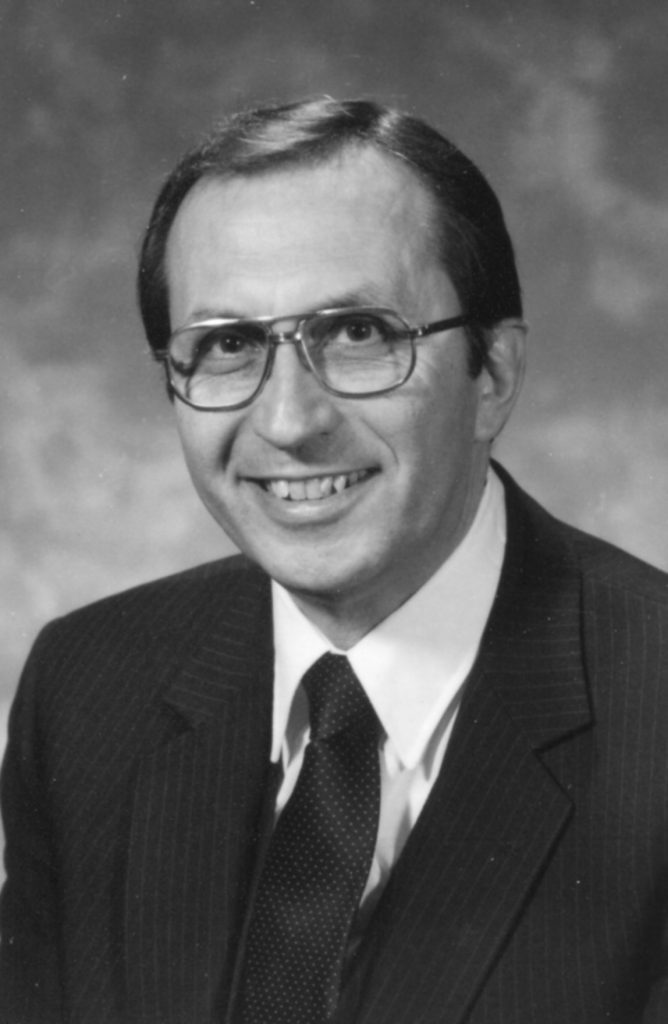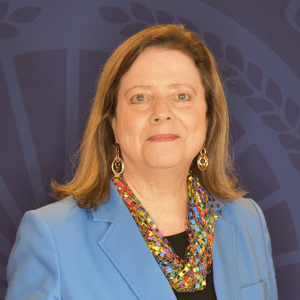Did you know that the first president of EMU resigned in a dispute about allowing musical instruments in the home? Or, that the fifth president took office at age 35?
From its founding as Eastern Mennonite School in September 1917 up through today, EMU has been led by nine presidents who have guided it through times of turbulence and periods of prosperity.
In honor of Presidents’ Day, we bring you a brief summary of EMU’s eight presidents emeriti and some of their enduring accomplishments.
The information below is taken from the profiles at emu.edu/president/emeriti. Click on the link to read more in-depth histories of each president.

J.B. Smith
President from 1917 to 1922
When J.B. Smith, the first president — or principal, as it was called at the time — of Eastern Mennonite School, arrived in Harrisonburg, Virginia, by train on Oct. 9, 1917, he found that several students had been waiting almost two weeks to start their studies. The next morning, he directed the first registration; classes started on Oct. 15.
Smith worked tirelessly to develop the school’s curriculum, hire faculty, recruit students, solicit support from Mennonite churches and expand the campus. He taught a number of courses, and students loved and admired him.
Smith resigned in January 1922 in a dispute about Mennonite churches maintaining their a cappella singing tradition by banning musical instruments in the church as well as in the home. He did not agree that instruments should be banned in the home, and he and his wife had recently purchased a piano.

A.D. Wenger
President from 1922 to 1935
Raised on a farm near Harrisonburg, A.D. Wenger, a founder of EMS, had already twice declined to accept administrative positions at the school before being elected as the second principal of the school in February 1922.
One of the first tasks that Wenger tackled as principal was what he called a “mountain of debt” that remained from the school’s start-up and construction of the Administration Bulding. In 1930, the junior college achieved state accreditation — probably the greatest accomplishment of the Wenger years.
Wenger, whose title was changed to “president” in 1926, presided over a school hard hit by the Great Depression for most of the 1930s. Enrollment declined, financial contributions decreased and faculty positions were cut. Salaries, which were already low, were reduced. Wenger died suddenly in his home on Oct. 5, 1935, at age 67.

John L. Stauffer
President from 1935 to 1948
Two days after Wenger’s death, the EMS board appointed John L. Stauffer, a charter member of the EMS board, professor and ordained minister, as acting president. He was elected president 13 months later.
During Stauffer’s 13-year presidency, the student numbers increased from 159 to 442. He, along with longtime Dean C.K. Lehman and others, worked for years to achieve accreditation for EMS as a four-year college. This was finally accomplished in 1947. That fall, the school officially became Eastern Mennonite College.
In 1948, Stauffer asked for and received a sabbatical leave, feeling that he had served his time and that he should step aside for a younger person with more formal education.

John R. Mumaw
President from 1948 to 1965
Taking office as acting president of the newly renamed Eastern Mennonite College in the fall of 1948, John R. Mumaw had spent more than half his 44 years on campus — as student, staff member, campus pastor and professor. He was the first alumnus to be chosen president.
Throughout the 1950s, Mumaw led EMC in pursuit of regional accreditation by the Southern Association of Colleges and Schools. The college achieved regional accreditation in 1959. Enrollment during Mumaw’s 17 years as president increased 44 percent, from 475 to 843. EMC was one of the first colleges in Virginia, a racially segregated southern state, to integrate (in 1948).
In the early 1960s, Mumaw started talking about leaving the presidency, but he agreed to stay on until 1965.

Myron S. Augsburger
President from 1965 to 1980
When he took office as president of EMC at the age of 35 — the youngest president ever — Myron S. Augsburger was already a nationally recognized evangelical leader.
He gave passion to the office. Drama, instrumental music, intercollegiate athletics and international study developed dramatically. The seminary program was strengthened, and EMC changed its official name to Eastern Mennonite College & Seminary. The two biggest building projects during the Augsburger years were the domed state-of-the-art facility later named Suter Science Center, which opened in 1968, and the building that later became Hartzler Library.
After 15 years of work to strengthen EMC&S, Augsburger decided to resign in 1980 to pursue other interests.

Richard C. Detweiler
President from 1980 to 1987
The EMC board recruited a respected 55-year-old churchman from eastern Pennsylvania, Richard C. Detweiler, to succeed Augsburger.
Under Detweiler, then-academic dean Albert Keim led a consultative process with the faculty that resulted in one of the cornerstones of undergraduate education to this day: a requirement, beginning in 1982, that students be exposed to cross-cultural matters through study and experience.
The biggest crisis of Detweiler’s tenure was the 1984 fire that destroyed the Administration Building during a major renovation. The building was unoccupied at the time, but the tragedy affected campus morale, and Detweiler faced the challenge of slumping enrollments and budget cuts that affected faculty and programs. By the time he left EMC&S, however, the student population was on the increase again and a striking new Campus Center stood on the side of the hill where the “Ad” Building had once stood.
In 1987, Detweiler resigned from the presidency, saying his years at EMC&S were “the most enjoyable and most difficult” of his life.

Joseph L. Lapp
President from 1987 to 2003
Like his immediate predecessor, Joseph L. Lapp was a native of eastern Pennsylvania. But unlike all six of his predecessors, he was not an ordained minister. He was a lawyer by profession.
His biggest accomplishments were starting four graduate programs — counseling, conflict transformation, education and business — in the 1990s, and, as a result, ushering in the new name of Eastern Mennonite University in August 1994. Under Lapp’s leadership, EMU expanded its innovative cross-cultural program. EMU made numerous campus improvements that culminated in the University Commons complex that includes the Yoder Arena. The building opened in 2000.
After 16 years as president, Lapp departed in 2003 to join the staff of Mennonite Foundation (now part of Everence), directing its Harrisonburg office.

Loren E. Swartzendruber
President from 2003 to 2016
Although elected in 2003, Loren E. Swartzendruber did not actually take office until January 2004. He spent the intervening months in preparation for the presidency. Provost Beryl Brubaker was interim president from June to December.
Among Swartzendruber’s accomplishments were the successful re-accreditation process for another 10 years by the Southern Association of Colleges and Schools, filling key administrative positions with talented people, and leading the university through economic hard times while balancing the budget.
One of the biggest building projects during his administration was “Phase Two” of the University Commons project (completed in 2011) in which the old Student Center was transformed into a main stage theater, studio theater, art gallery, classrooms, advanced media lab, and expanded coffee shop. Other accomplishments included EMU’s groundbreaking solar installation on the roof of the Hartzler Library and attendance with alumna Leymah Gbowee at the Nobel Peace Prize ceremony.
Swartzendruber retired in June 2016 after 13 years as president.
Current president

Dr. Susan Schultz Huxman has served as EMU’s ninth president since Jan. 1, 2017. During her leadership, EMU has shattered records for donor giving — mark your calendars for this year’s LovEMU Giving Day on Wednesday, April 10 — and the university has garnered its share of the national spotlight with high rankings by U.S. News & World Report and Money Magazine.
Among the building projects completed while she’s been at the helm, renovations for Suter Science Center West were finished and dedicated in October 2021. Along with new seating, lighting and upgraded technology for S-106, Suter West renovations included modernized classrooms, new laboratory space for EMU’s engineering program, upgrading of the discovery room and expanded displays from the D. Ralph Hostetter Natural History Collection, upgraded climate-control system and an improved sprinkler system.
Another major project, which is nearing the finish line, is the new track-and-field complex being built. The $6-million complex, which is more than halfway funded, is scheduled to open this year. Donations are accepted online at: https://emu.edu/campaign/track-and-field.
Huxman has served for more than 25 years in higher education in a variety of administrative and academic leadership roles. A graduate of Bethel College, Huxman holds an MA and PhD in communication studies from University of Kansas.
Interim presidents
Over the years, three interim presidents have kept the business of the university moving forward: Beryl Brubaker (May-December 2003), Fred Kniss (May-August 2013 for Swartzendruber’s sabbatical), and Lee Snyder (July-December 2016).
